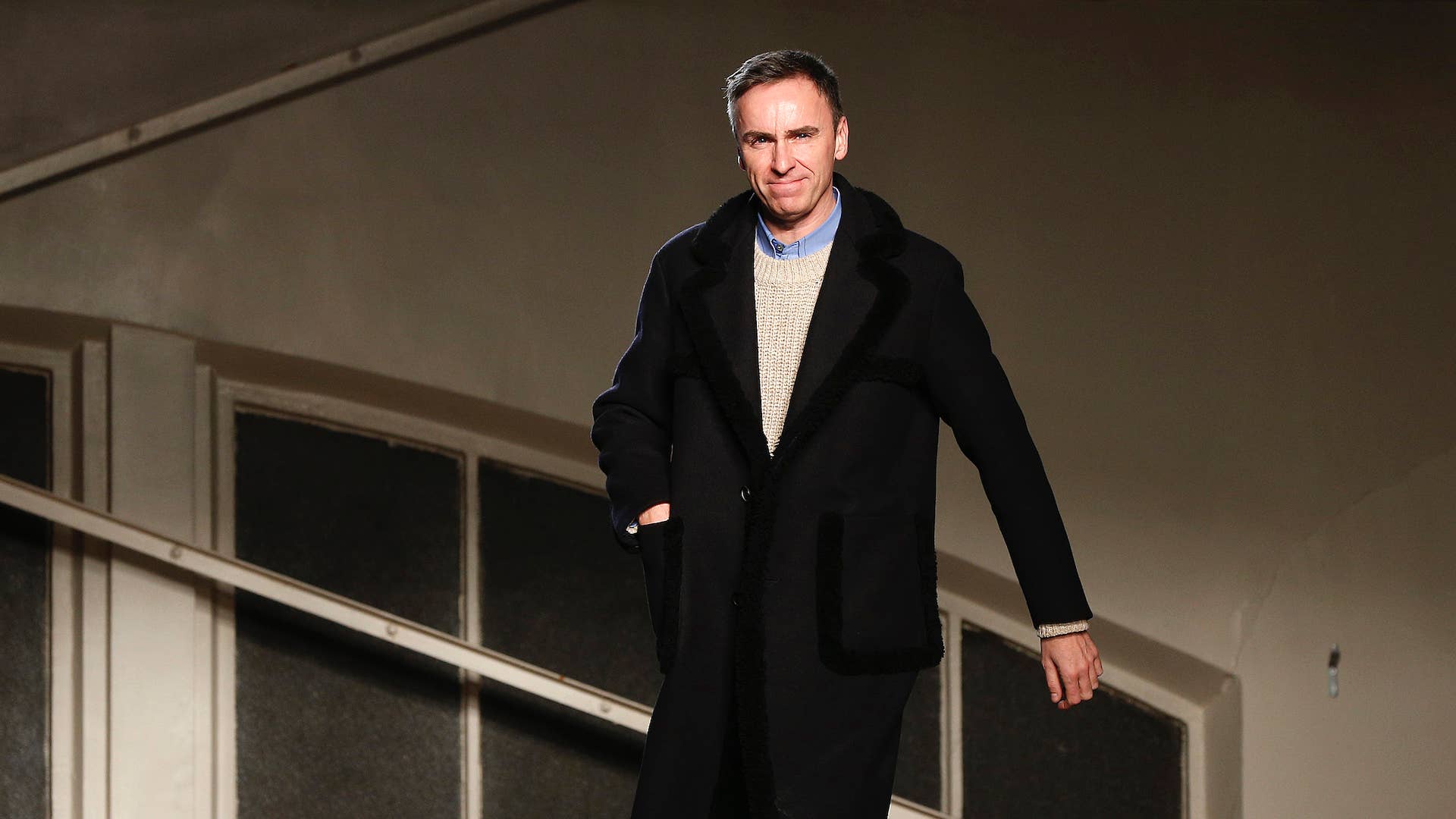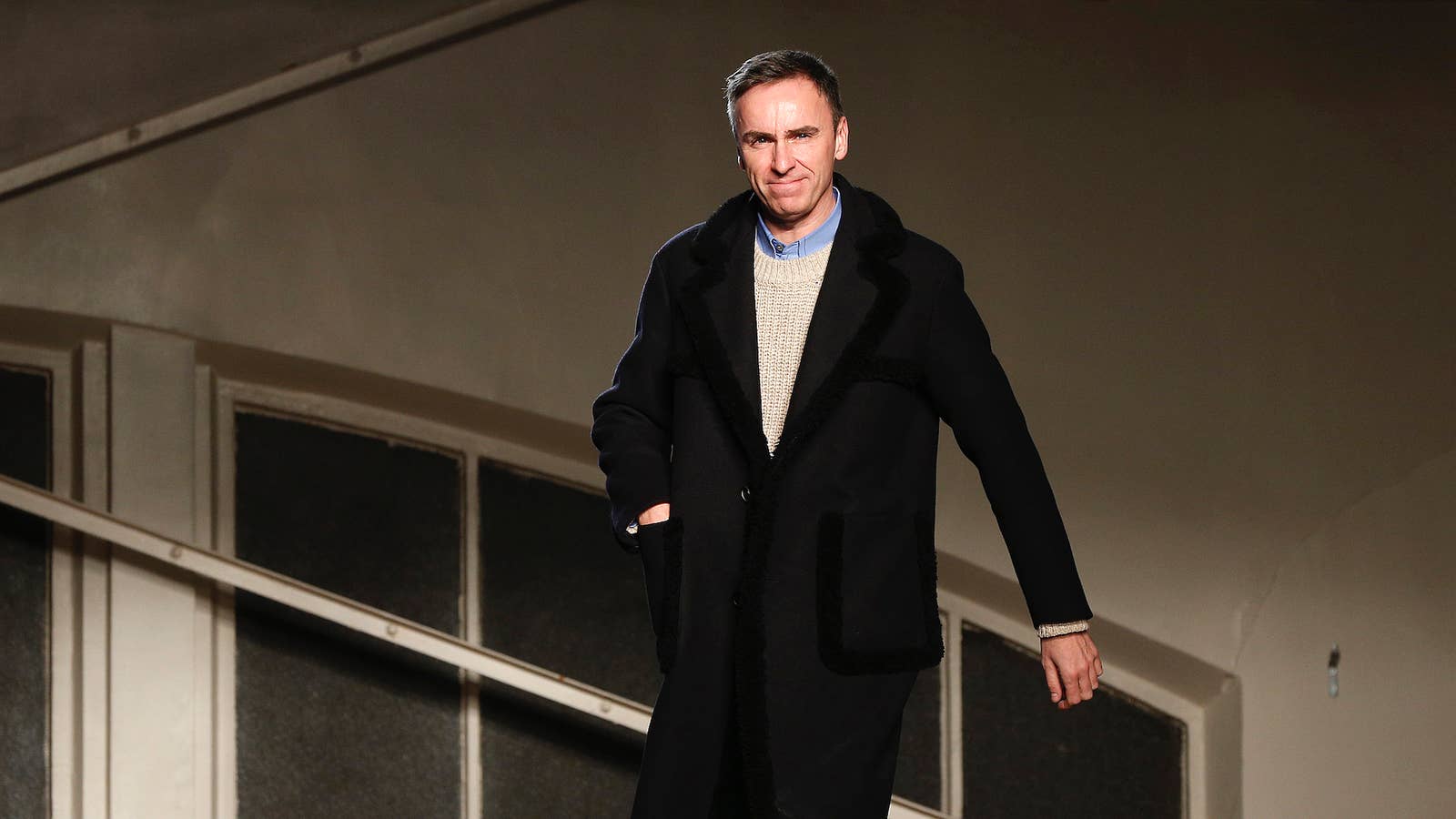
This year, the fashion world buzzed with excitement when it was confirmed that Raf Simons would officially join the house of Prada as a co-creative director starting in April. The Belgian designer’s appointment at Prada made him the first designer to ever be hired outside the Prada family since the house was first founded over 100 years ago. Following stints at Jil Sander, Dior, and Calvin Klein, there is a reason why Raf Simons is one of the world’s most revered menswear designers today.
“I think what drew me to his work was his intellectualized view of current culture. His approach is so reality-based,” said Virgil Abloh in a Vogue interview on Raf Simons’ impact. “His early work is social commentary on being young, and that approach to fashion resonates with me the most.”
With a keen eye for youth subcultures, music, and art, Raf Simons flipped teenage rebellion into fashionable garments that evoke individuality in menswear. As Kanye West declared to Vogue after the premiere of his first Yeezy collection: “You guys know my fucking influences. You see Raf Simons right there.” Although Raf Simons has become a household name ever since people like ASAP Rocky, West, and Abloh cosigned him, Simons’ clothes have been influencing streetwear and men's fashion for years. So to understand the hype behind archival Raf Simons pieces—like the “Riot! Riot! Riot!” bomber jacket Drake wore in his recent music video for “Toosie Slide”—let’s take some time to trace the evolution of Raf Simons to better understand why he’s one of the most deified menswear designers working today.
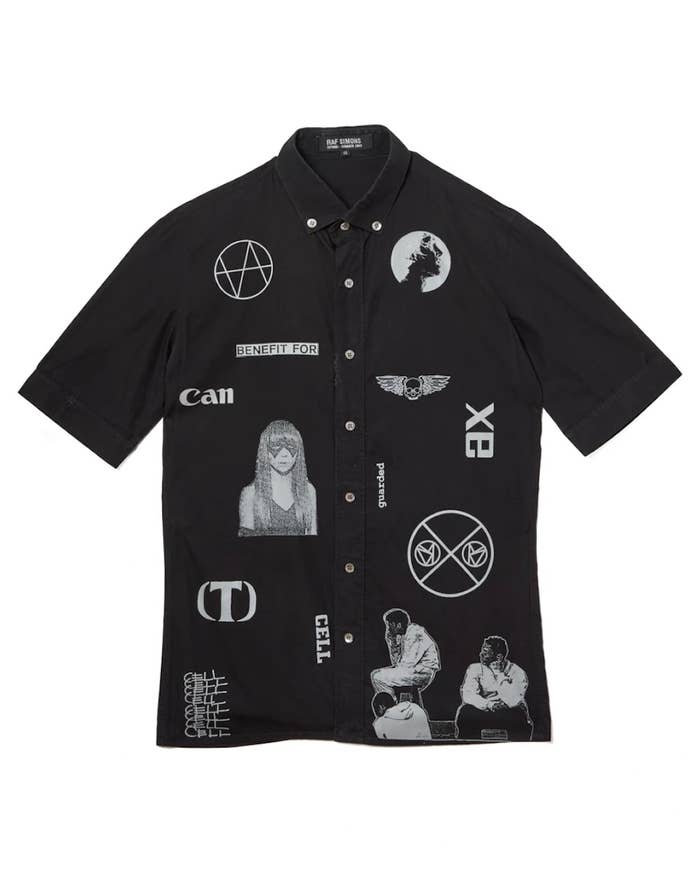
Simons never went to school for fashion design. He graduated from Belgium’s LUCA School of Arts with a degree in industrial and furniture design in 1991. During Simons’ last year at school, he interned for Walter van Beirendonck, an influential fashion designer who was a part of the legendary group of game changing fashion designers known as the Antwerp Six. Simons built out showroom displays and designed invitations for the pioneering Belgian designer. Although Simons admitted to 032c that he was into wearing garments by designers like Helmut Lang, he had never thought about designing clothing himself until the Spring/Summer season of 1990. This was when Beirendonck brought Simons to Martin Margiela’s groundbreaking Spring 1990 fashion show that was held inside a playground on the outskirts of Paris. Simons broke out in tears while watching the show and had an epiphany about what he wanted to do as a designer. “I knew they were glamorous events from TV, but when I saw Martin’s show, I was nailed to the ground,” he told 032c. “It was so socially aware, psychological, and surreal. At that show I said, ‘That’s what I am going to do.’”
Beirendonck eventually connected Simons with Linda Loppa, the head of fashion at the Royal Academy of Fine Arts. According to the Simons himself, when he approached Loppa about possibly attending the Academy, Loppa immediately shot the idea down and told him to simply start producing garments with whatever design knowledge he already had. So Simons’ made a test collection for Loppa that consisted of skinny black suits and skinny sleeveless shirts that looked like school uniforms. After seeing Simons’ first collection, Loppa immediately connected him to an agent in Milan so he could set up his first showroom in 1995. That became Simons’ first season and he was immediately able to sell his garments to clients from Japan and even Barneys. This is how Raf Simons’ eponymous label was born.
According to his 2016 interview with The New York Times, Simons focused on menswear because the two female partners he originally had dropped out. So his label started as an “one man show.” And the first 40-50 pieces that Simons designed were even fitted onto himself. But Simons was never trying to design a men’s collection per se. He was trying to make clothing that would speak to his generation and the teenagers who grew up around Antwerp. This explains why Raf Simons’ models like Robbie Snelders were street casted. It added an air of authenticity to the garments. After all, the clothes reflected what those boys were actually wearing at the time. As noted in a profile in The Guardian, Simons didn’t just have the boys in his show, they directly informed his designs. “He talked to the boys about their lives and their opinions on his clothes. ‘These kids, they didn't care. If one in 40 said [your design] is shit, you thought: he has no taste. If 20 said it, you think: maybe this isn't what this generation is interested in.”
It was the beginning of a new era in not just high fashion, but street fashion as well. The first couple of seasons established Raf Simons’ focus on capturing youth subculture. While presenting it in a way that both fashion critics and street kids could understand and enjoy. The critics appreciated the tailoring and shape of his garments. While the youth could find themselves actually wearing them.
Simons’ first runway show was held in the Fall/Winter 1997 season. The collection spun the “Ivy Look” on its head, taking once-prep school designs and altering shape and silhouette to filter the schoolboy uniform through new wave and punk music. Simons understood that kids would alter their uniforms to fit their personal style, and like Angus Young and AC/DC in the ‘70s, this was just the latest iteration of music’s role in youthful rebellion. His Spring/Summer 1997 collection, “16, 17 How to Talk to Your Teen” wasn’t just poking fun at the classic “parents just don’t understand” phrase, it was his way of tackling the disenfranchised youth that were separating themselves from society.
Music has always played a significant part in Simons’ collections. His Fall/Winter 1998 show dressed models like members of seminal electro group Kraftwerk, pairing red shirts with black ties as a nod to the group’s 1978 album Man Machine. His Spring/Summer 2000 collection combed the influences of high-IQ MENSA students and Gabba–a niche genre of hardcore Dutch techno–clubgoers to inform his designs.Military-surplus style bomber jackets mixed with V-neck wool sweaters and checked zip-ups—as seen in the book Isolated Heroes—show Simons taking the seemingly isolated youth of a niche subculture, and photographed them in a new romanticism that mirrored classical sculpture. Considering the models were all “street cast” for the book, the intention was to portray the boys in their purest form—showing the faces that inspired Simons in a very particular time around the year 2000. Pieces from this collection would go on to become cult favorites and are highly sought after.
After taking a break following his Fall/Winter 2000 runway show, Simons returned with his classic “Riot, Riot, Riot” Fall/Winter 2001 collection. Like the Spring/Summer 2002 collection –“Woe Onto Those Who Spit On The Fear Generation...The Wind Will Blow It Back”–these collections would be characterized by oversized jackets, drapey black hoodies, and the heavy influence of authentic military surplus. Instead of using the innocence of youth finding themselves through their respective subcultures, Simons instead focused on the militant side of teenage rebellion. Simon's musical influences shined through on patches that referenced bands like the Manic Street Preachers. Simons’ focus on less-militant youth archetypes would resume with his “Virginia Creeper” collection in Fall/Winter 2002. It was so influential—via the tree-covered runway, and distinctly destroyed pieces—that it would go on to directly influence future runway shows. For example, Off-White’s Spring/Summer 2015 womenswear collection was titled “Nebraska” and featured collegiate pieces reminiscent of the ones seen in “Virginia Creeper.”
Simons’ collections in the early 2000s have become some of his most iconic, starting with his collaboration with Peter Saville. The designer was given full access to the legendary British graphic designer’s archive for his Fall/Winter 2003 “Closer” collection. This season was full of graphics from the seminal bands that informed the subcultural styles Simons often drew from, like Joy Division and New Order. For Fall/Winter 2004, Simons plastered Joy Division’s Unknown Pleasures album art on the back of a leather jacket and New Order's Power, Corruption, and Lies art on fishtail parkas. These pieces are considered to be some of Raf Simons’ most sought after grails.
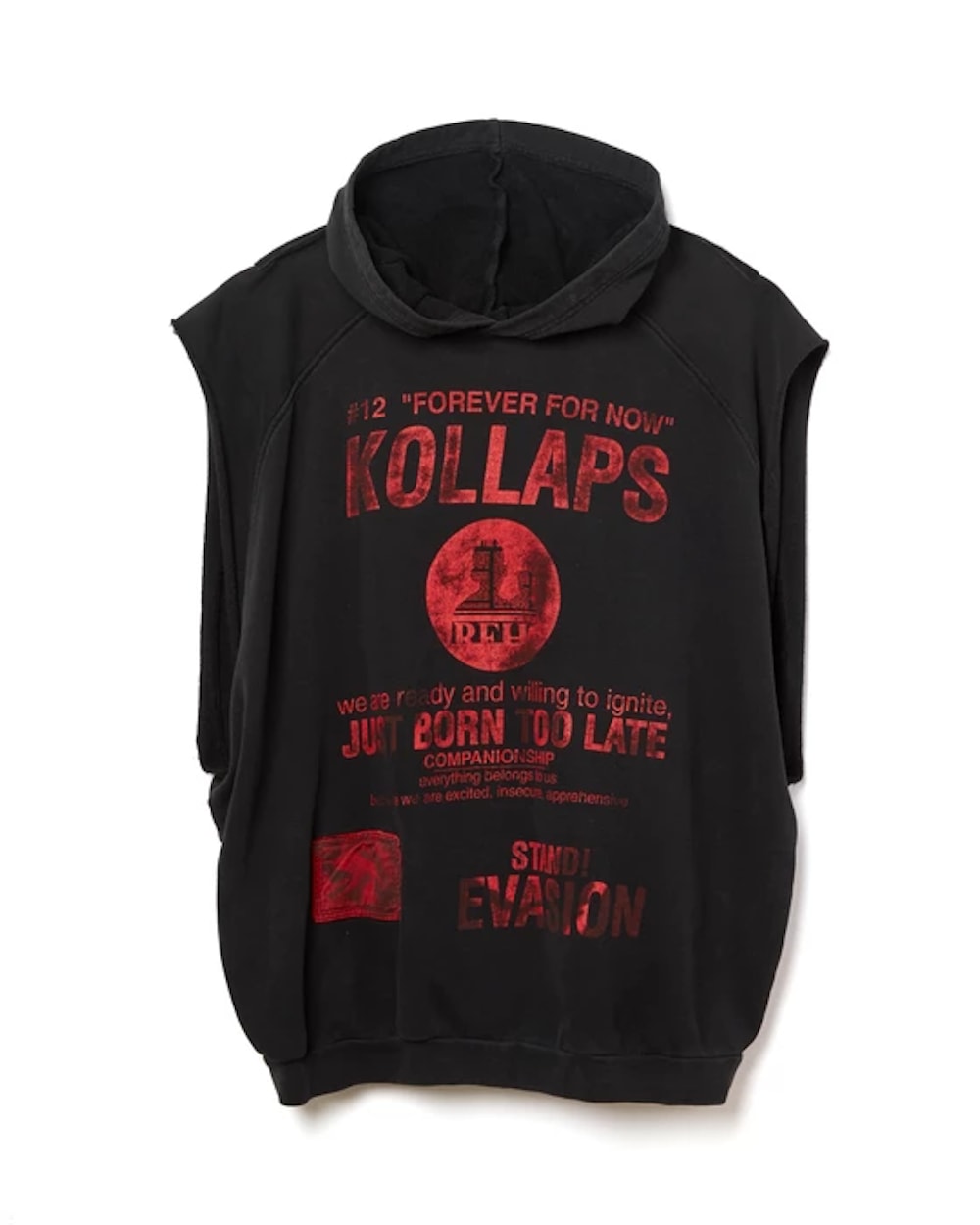
By 2004, Simons had shown his ability to pull off both tailored and baggy silhouettes, but as former Arena Homme Plus editor Jo-Ann Furniss wrote, “The key turning point was A/W ‘04-05 (Waves), when the obsessive youth culture codes of his past were turned into clothes that were purely about shape and form.” This became apparent in July of 2005, when Simons began his position as the creative director of Jil Sander. This was when Simons began designing his first womenswear collections, carefully conceiving innovative shapes and silhouettes, while maintaining the minimalism that Jil Sander was known for. Although Simons' seven year tenure at Jil Sander is defined by his work for their womenswear line, his menswear collections are also revered. One example is Jil Sander’s Fall/Winter 2008 “Marble” collection, which infamously appeared in that iconic street-style photo of Virgil Abloh and Kanye West’s crew at Paris Fashion Week. During this time, Simons’ also increased the commercial appeal of Jil Sander and his own label by creating diffusion lines like Jil Sander Navy and Raf by Raf Simons respectively.
On top of his appointment at Jil Sander in 2005, Simons celebrated the first 10 years of his brand with the release of the Raf Simons: Redux book and a retrospective exhibition at the Pitti Uomo trade show, which is also where he presented his Spring/Summer 2006 collection. This collection, using Simons’ penchant for oversized shapes, also incorporates some of the minimalism found in Jil Sander—especially in the color palette. In 2008, Raf Simons began collaborating with Fred Perry, a British brand that was quintessential to the wardrobes of teen mods and skinheads in the ‘60s and ‘70s, which is why this ongoing partnership still makes sense today.
Along with music, understanding Simons’ love for art is essential when delving into the designer’s illustrious career. Simons has historically stayed extremely close with the creatives he’s worked with, such as the photographer Willy Vanderperre, who has shot almost all of Raf Simons’ campaigns. For his Spring 2017 collection, Simons placed images by the American photographer Robert Mapplethorpe on a number of garments. And some of the most memorable products released during Simons’ short stint as the Chief Creative Officer of Calvin Klein were pieces embellished with Andy Warhol’s photographs. However, the one artist that is quintessential to Raf Simons’ career is none other than the contemporary Los Angeles based artist, Sterling Ruby.
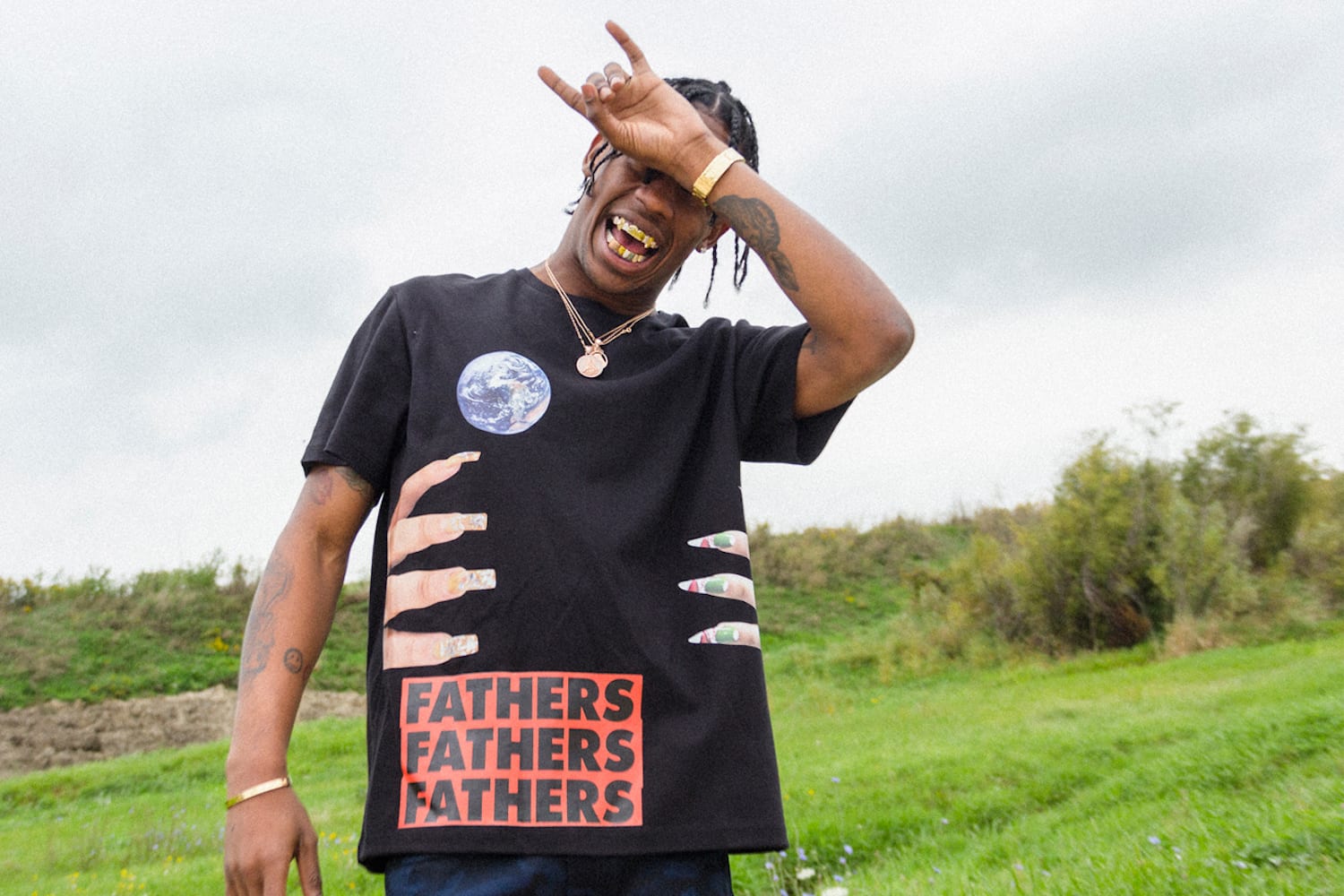
Simons long relationship with Ruby first began in 2007, when Simons first tapped the artist to help design the interior of the first Raf Simons store in Tokyo. From there, they collaborated on a capsule collection of bleached denim garments in 2010 which featured Ruby’s iconic splatter paint style. Simons would sample Ruby’s art again for his premiere Dior couture collection—when Simons was the creative director of the line from 2012 to 2015 . However, Ruby’s most iconic collaboration with Simons arrived with their landmark collaboration in Fall 2014. Standout pieces from the Raf Simons x Sterling Ruby collection include a limited run of paint-splattered trench coats that retailed for $30,000, skinny jeans with bands that read “Abus Lang” on the knee, and graphic trench coats that featured Ruby’s collages. It was a collection that was inspired by much of the young, punk aesthetics that have informed both Ruby and Simons throughout their careers–Ruby went on to launch his own brand in 2019. By having a collection in recent history that was able to have the same youthful spirit that made Simons so iconic in the ‘90s, it would spark contemporary interest in Simons’ designs. The only difference is that now, instead of New Wave and Gabba, the driving musical force behind Raf Simons’ hype today is contemporary hip-hop culture –“Please don’t touch my Raf.”
Sneakerheads have also become ardent Raf Simons fans, too. One of Simons’ most iconic shoes comes in the form of his hiking boot-sneaker hybrid, an homage to the Dutch “De Stijl” art style, which was notably seen on A$AP Rocky on numerous occasions. This was just one of Simons’ earliest conceptual sneaker designs. His Fall/Winter 2010 collection introduced a 20-holed multi-laced high-top, the hyper rare Nike-inspired Vandals, and the grail-status Astronaut sneakers. In 2013, Raf Simons began his popular collaboration with Adidas, adding crazy color combinations, materials and patterns to silhouettes like the Ozweego 2, Bounce, and Response Trail Runner. His popular Stan Smith collaboration has garnered both ire and respect since it is practically untouched—Simons’ changed nothing about the shoe aside from replacing adidas’ three stripes with a perforated “R”.
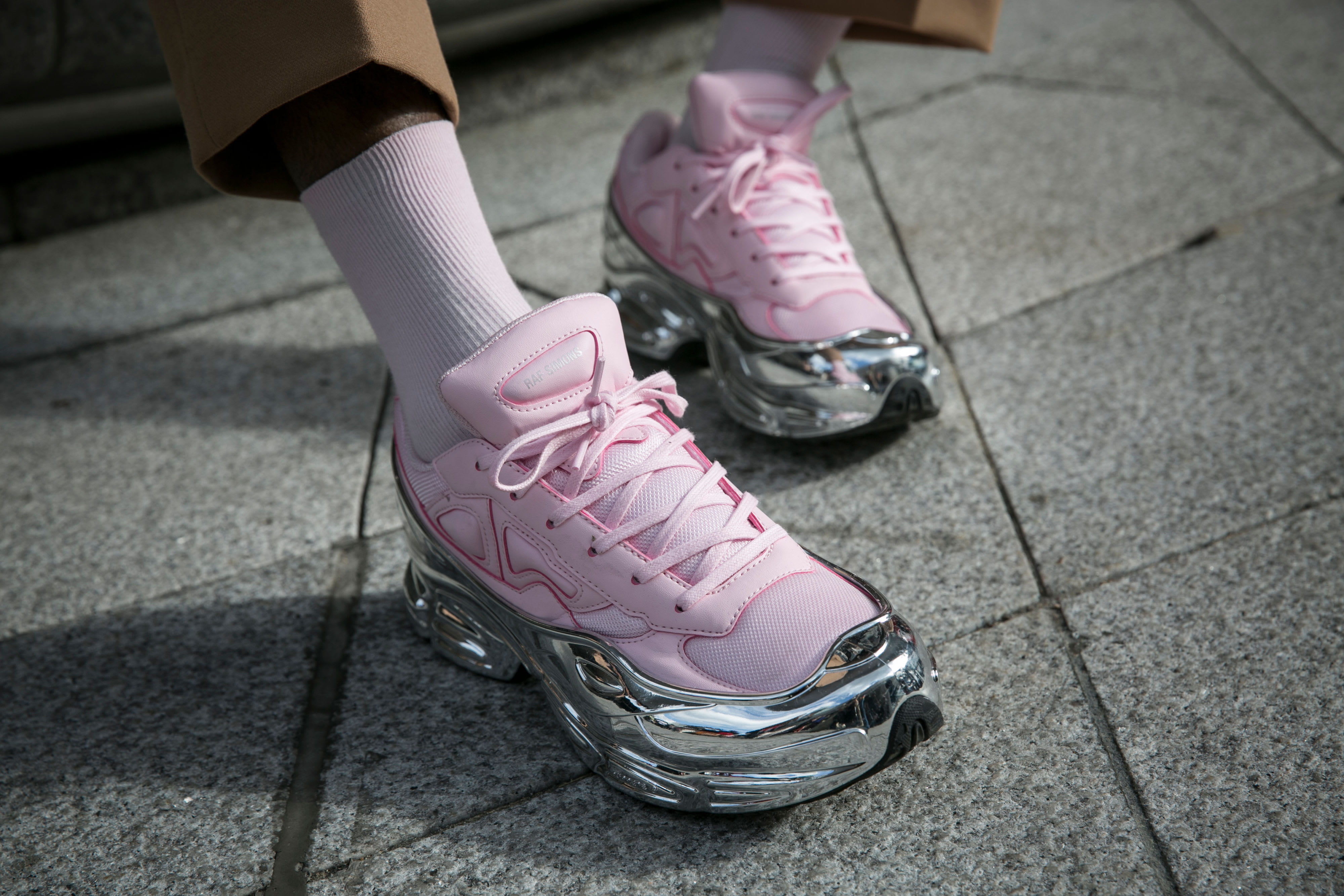
Although many know Raf Simons’ fans drool over his work in the early 2000s, Simons has never stopped pushing boundaries and delivering iconic collections. Oversized “I Love New York” knit sweaters from his memorable Fall/Winter 2017 runway show in Chinatown, New York have quickly become Raf Simons’ grails. Whereas his Fall/Winter 2018 collection is well remembered for touching upon the ubiquitous presence of drugs in society and our relationships with addiction. Even during his short two year stint at Calvin Klein, which ended due to creative differences, Simons created historic moments for the brand. Along with winning two CFDA awards for Calvin Klein’s menswear and womenswear collections in 2017, Simons created iconic pop culture moments such as featuring the ASAP Mob in Calvin Klein ad campaigns. Although Simons’ work at Calvin Klein was applauded by critics, his avant-garde vision was eventually seen as financially unfeasible for Calvin Klein–a brand mostly known for mass-marketing underwear and denim. After Simons left, Calvin Klein decided to not seek out another high profile designer.
Although we can keep talking about the impact of Simons’ work for days, A$AP Rocky’s comment to Complex about Simons’ time at Calvin Klein explains it the best: “You have to disrupt, and not do what is safe and expected. Fuck being normal.” Simons’ inherent desire is to accurately recreate the cacophony of influences that inspire young adults even to this day. “The past is not romantic to me. The future is romantic to me,” he says in his 032c profile. It’s this mentality that allows him to channel the frustrations of youth season after season—long after Simons, and many of his fans, have left adolescence behind. “I like creating something that is not only about me, it’s about people who can relate to that thing and all together it becomes an environment.”

